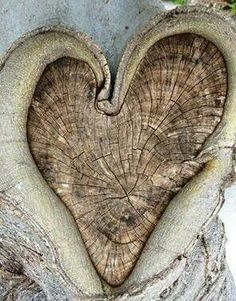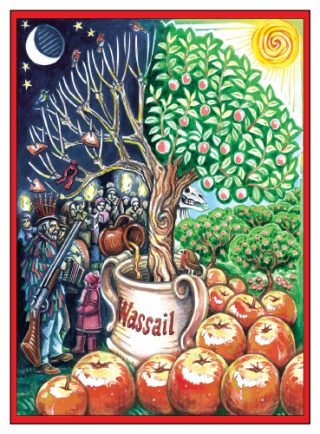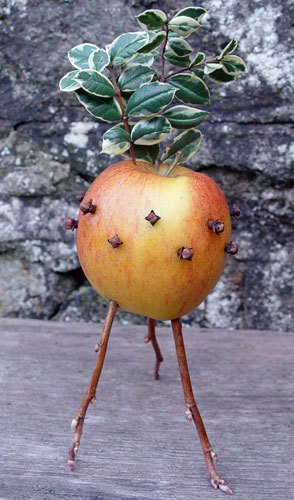APPLES IN WINTER
The apple tree is a tree that was born in the mountains of Central Asia and it has spread along the commercial “silk road”, moving to the west. It is commonly believed that it was the ancient Romans who brought the apple tree to Britain, yet the most recent archaeological excavations in Armagh (Northern Ireland) found apple seeds dating back to the 10th century BC. In fact, the apple appears in many Druidic teachings and in Celtic poetry and mythology.
The apples are stored for a long time in a cool and dry place like attics, becoming one of the few fruits that can be eaten in winter.
AILLIN & BAILE
 The apple tree is the embodiment of the female principle; a medieval narration tells us the love story of Aillin and Baile, two children in love to whom the Druids had prophesied that they would never meet in life, but only after death to never separate again: the macabre (or romantic) prophecy came true magically with the union of the wood of two trees, the apple and the yew grown on their graves!
The apple tree is the embodiment of the female principle; a medieval narration tells us the love story of Aillin and Baile, two children in love to whom the Druids had prophesied that they would never meet in life, but only after death to never separate again: the macabre (or romantic) prophecy came true magically with the union of the wood of two trees, the apple and the yew grown on their graves!
The legend is set at the time of Celtic Ireland by King Cormac mac Airt (II-IV century), but it is somewhat inconsistent with respect to the archaeological sources in our possession; they tell the story of the “taball filidh” (the poet’s tablet) -probably a wooden tablet or a waxed tablet in use with the ancient Greeks and Romans – one made from the wood of the apple tree of Aillin and the other from the wood of the Baile rate, that they indissolubly linked to each other when they found themselves nearby for the first time (to Samain during the party presided over by Art, son of Conn of the Hundred Battles, king of Erinn). If the story were true, the bards of Ireland writed they poems on wooden tablets; these two tablets were one from Leinster (apple), the other from Ulster (rate) and for their magical adherence were preserved as rarities in the treasure of Tara.
The story seems to be a variant of the love knot between the rose and thorn, recalled in the medieval ballads (grown from the respective tombs of the unfortunate lovers, they come together and intertwine with each other).
But the main association of the apple tree with the Celtic world is the Island of the apples, Avalon, the land of the Fairies.
Geoffrey of Monmouth writes in the Historia Regum Britanniae (1136)
“Insula pomorum quæ fortunata vocatur,
Ex re nomen habet, quia se singula profert.
Non opus est illi sulcantibus arva colonis,
Omnis abest cultus, nisi quem natura ministrat,
Ultro fœcundas segetes producit, & herbas,
Nataque poma suis prætonso germine sylvis.
The isle of Apples, truly fortunate,
Where unforc’d goods and willing comforts meet.
Not there the fields require the rustick’s hand,
But nature only cultivates the land.
The fertile plains with corn and herbs are proud,
And golden apples smile in ev’ry wood.“.
Fairies’ food that can make immortal or restore health to the sick, the apple is the basis of the preparation of cider, a low-alcohol drink obtained from the fermentation of fruits such as apples, pears or loquats, typical of the United Kingdom, Basque Country and of Normandy. see

APPLE WASSAIL

The oldest form of the winter celebration of the Wassail provides the blessing of trees and bees, so important for pollination, in order to ensure a healthy harvest for the next year.
“Apple Wassail”, is the blessing of the orchards: during the ritual they sing and make a spell, with a great noise they beating pots and pans (or shooting in the air) to ward off evil spirits, pourring some cider around the roots of the oldest tree; finally all drink to the health of the apple trees and the future harvest, eating sweet buns, and leaving a slice to the spirit of tree (to feed the robins), placed on the branches of the plant as thanksgiving.
(see more)
HEL CALENNIG (GALLES) 
The second rite comes from Wales called “Hel Calennig” (Literally “the hunt of the Calends”) based on the ancient tradition of exchanging a gift for the first of January. (some scholars believe that the ritual derives from the customs practiced in the Roman Empire for the New Year. see Strenia)
“Hel Calennig” is a Welsh tradition of the first day of the new year: an apple impaled on three sticks like a tripod, decorated with cloves and a sprig evergreen. This “trophy” is brought as a gift (or shown) in the neighbors’ house by the children singing a good-luck song.
In return they receive bread and cheese or some coins.
| Blwyddyn newydd dda i chwi, Gwyliau llawen i chwi, Meistr a meistres bob un trwy’r ty, Gwyliau llawen i chwi, Codwch yn foreu, a rheswch y tan, A cherddwch i’r ffynon i ymofyn dwr glan. |
A happy new year to you, May your holidays be merry, Master and mistress – everyone in the house; May your holidays be merry, Arise in the morning; bestir the fire, And go to the well to fetch fresh water |
The New Year is also the Hoodening Day in Wales when Mari Lwyd, “Y Fari Lwyd” (in English “Gray Mare”) is brought home.
MARI LWYD

Mari Lwyd is the Welsh version of the hooden horse. Tradition still practiced in central and south Wales, in particular in Llantrisant and Pontyclun on New Year’s Eve. The mask consists of a horse’s head (a real skull) with movable jaw and disquieting eyes made from two pieces of green bottle, decorated with colored ribbons and carried on a pole by a person hidden under a wide white sheet.
The wassailers stop to sing in front of the doors of the houses and call the mistress and challenge her in a pwnco, a sort of debate between the two sides, often with insolent verses. The victory of the singing challenge allows the wassailers to enter the house to eat sweets and drink beer.
As we can see in the illustration, the landlady holds a broom in her hand and she does not want to let the wassailers enter, because they are bringers of chaos.
The revel as all the rituals of the peasant world requires a certain degree of drunkenness and harassing behavior. In fact, the mare will turn around the room trying to take the women, she is clearly a monstrous and otherworldly creature who must be appeased with some offers. Sometimes a small child stands with a sweet and manages to calm the beast. keep it going. see more
I Here we come Dear friends To ask permissions to sing II If we don’t have permission, Let us know in song How we should go away tonight III I have no dinner Or money to spend To give you welcome tonight |
Welsh gaelic I Wel dyma ni’n dwad Gyfeillion diniwad I ofyn am gennod i ganu II Os na chawn ni gennad Rhowch wybod ar ganiad Pa fodd mae’r ‘madawiad, nos heno III ‘Does genni ddim cinio Nac arian iw gwario I wneud i chwi roeso, nos heno |
NOTE
1) if the people of the house were defeated in the poetic contest, the Mari Lwyd claimed the right to stay at dinner with all his followers. Alternatively they offered a glennig, (a small tip), a glass of glaster, (water and milk) or beer
At Cwm Gwaun (Gwaun Valley), above Abergwaun (Fishguard), the community celebrates Yr Hen Galan (the old New Year) on January 13, according to the calendar prior to 1752.
Even in Wales as in Scotland is still rooted the practice of Firstfoot: here must be a man with a lucky name (Dafydd, Sion, Ifan or Siencyn), or alternatively a woman with a lucky name (Sian, Sioned, Mair or Marged ); in New Year’s Eve there was also a wren hunting.
APPLES IN WINTER JIG
The “Apples in winter” is an Irish jig also known by many other titles (see)
David Power uillean pipe & Willie Kelly violin in “Apples in winter” (n enjoyable cd of jigs and reels + some traditional Irish air)
Dervish
Anglo concertina, Cittern, & Guitar
Ardan
LINK
http://bifrost.it/CELTI/4.Eriuiltempoelospazio/05-Soprannaturale.html
http://www.unamelaalgiorno.com/la-mela-nella-cultura-celtica.html
http://icoloridelvento-mirial.blogspot.it/2015/10/il-melo-e-il-frutto-della-conoscenza.html
http://www.laltrafacciadellamela.altervista.org/
https://isimbolinellacomunicazione.wordpress.com/2013/02/21/la-mela/
http://www.amando.it/ricette/alimenti/mela.html
http://ontanomagico.altervista.org/johnny-jump.htm
https://museum.wales/articles/2014-06-14/Christmas-customs-Hel-Calennig/
https://lilydewaruile.wordpress.com/tag/calennig/
SCORES
https://thesession.org/tunes/299
http://tunearch.org/wiki/Apples_in_Winter_(1)
http://spokanesessions.com/tune.php?tune=1
http://www.celticguitarmusic.com/tbj_apples_winter.htm

